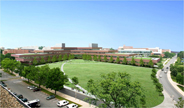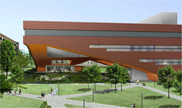
Reflection
Being able to participate in the IPD/BIM Thesis proved to be a very rewarding experience. The constant interaction and feedback from everyone in Buidling Stimulus allowed me to achieve a greater understanding and depth of the Millennium Science Complex holistically, more so than an individual thesis could have allowed me. Collaboration throughout the design process, especially when implementing the double-skin facade (which proved to subsist as an educational exercise) truly exemplified the effects that each student's discipline attributes to one another.
This collaboration allowed me to not only develop my technical skills as a mechanical designer but it also greatly enhanced my communication skills since effective communication amongst the disciplines proved to be a valuable asset in order to reach optimal compromises. Also, the use of BIM to model the actual systems embodied the notion that each building and it's repective energy profile is unique. Therefore, more realistic information can be used to simulate the building's actual performance so that the best designs can be achieved.
Overall, by being able to have the chance to work on a design team comprised of four different disciplines, I feel it helped me experience a more realistic approach to design development and the priceless value in designs that result from an interdisciplinary team.
ABET Outcome Survey
Important Note: These outcomes reflect a personal (student) assessment of the course, not the instructor's assessment.
ABET Outcomes for AE 481W/482 |
Outcome not able to be assessed |
Level of ability demonstrated but below acceptable |
Minimum acceptable level of ability demonstrated |
More than minimum level of ability demonstrated |
(Score of 0) |
(Score of 1) |
(Score of 2) |
(Score of 3) |
a. An ability to apply knowledge of mathematics, science, and engineering |
|
|
|
|
b. An ability to analyze and interpret data |
|
|
|
|
c. An ability to design a system, component, or process to meet desired needs |
|
|
|
|
e. An ability to identify, formulate, and solve engineering problems |
|
|
|
|
f. An understanding of professional and ethical responsibility |
|
|
|
|
g. An ability to communicate effectively |
|
|
|
|
h. The broad education necessary to understand the impact of engineering solutions in a global and societal context |
|
|
|
|
i. An ability to engage in life-long learning |
|
|
|
|
j. A knowledge of contemporary issues |
|
|
|
|
k. An ability to use the techniques, skills, and modern engineering tools necessary for engineering practice |
|
|
|
|
o. Engineering design capabilities in at least two (2) of the (3) basic curriculum areas of architectural engineering, and that design has been integrated across the breadth of the program |
|
|
|
|
p. Communication and interaction with other design professionals in the execution of building projects |
|
|
|
|
Links
Note:
While great efforts have been taken to provide accurate and complete information on the pages of CPEP, please be aware that the information contained herewith is considered a work-in-progress for this thesis project. Modifications and changes related to the original building designs and construction methodologies for this senior thesis project are solely the interpretation of Sara Pace. Changes and discrepancies in no way imply that the original design contained errors or was flawed. Differing assumptions, code references, requirements, and methodologies have been incorporated into this thesis project; therefore, investigation results may vary from the original design.


